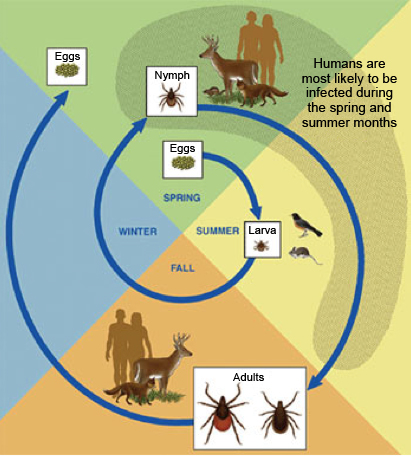Lyme disease transmission
Lyme disease is a tick-borne illness, so understanding the lifecycle of a tick is key to avoiding infection.
Ticks contract the Lyme disease bacterium (Borrelia burgdorferi) during their larval and nymphal stages by feeding on infected rodents and birds that carry the bacteria in their blood.
A tick’s lifecycle
Ticks take up to two years to complete their lifecycle in the natural environment. The exact timing depends on the tick species and the prevailing climactic conditions, with warmer temperatures generally leading to more rapid development. Illustration 1 shows that humans and their pets are more likely to encounter ticks during the spring or autumn than during the summer or deep winter, but once again, the exact season of risk varies according to geographical location.

How ticks infect people
Once a tick feeds on a Borrelia-infected host, it carries the bacteria in its belly (technically referred to as its ‘midgut’). When the tick starts to feed, the bacteria migrate from the midgut to the salivary glands, where they can be injected into the new host’s bloodstream. Hence, the longer a tick feeds on you without detection, the higher the risk of contracting Lyme disease.
As shown in Illustration 2 below, a tick can become infected with Borrelia in two ways:
- By drinking the blood of an infected host
- By retaining an infection acquired during a previous developmental stage
It is frequently stated that one is more likely to acquire the bacterium from an infected nymph than from an infected larva or adult. But this is due merely to circumstance rather than relative infectivity. The nymph is very small and hard to detect on even open skin let alone hard to see areas.
The even smaller Larvae were thought not transmit the bacterium to any host because an infected adult female will not pass the borrelia bacteria into the eggs. More recently though, another strain of borrelia that can infect humans has been shown to be passed from mother tick to the egg then to larvae meaning these sand grain sized, flesh coloured larvae can pass the borrelia pathogen to humans. In any case, in the wild, larvae normally feed only on small rodents but human transmission is likely but accidental and incidence is unknown. Infected nymphs and infected adults are equally capable of transmitting Lyme to humans. It’s just that nymphal ticks are very small (about the size of a poppy seed), so we are less likely to notice one feeding on us until they’ve grown to a larger size, by which time they are more likely to have transmitted the decease. See photo to the right to spot the two ticks attached to this child’s face, one is the dark freckle on the cheek and the other the less obvious dark freckle on the neck.
Feeding ticks secrete a local anaesthetic from their salivary glands, so that a host is less likely to notice that it has been bitten. This is why a thorough visual search for ticks at the end of a walk in the woods is so important.


Other modes of transmission
Lyme disease can be passed from mother to child during pregnancy. Research is currently underway to better understand this issue, but it is known that early diagnosis and treatment of pregnant mothers has been shown to improve outcomes for their babies. An extensive compilation of research on this subject can be found on the Lyme Hope website.
Tick-borne illnesses may also be transmitted in other ways
- Contaminated blood transfusions
- During pregnancy
- Fluid exchange during intercourse
- Exposure to feces from animals/people infected with Borrelia
- Other insects
Lyme disease is preventable and treatable. If you think you have been bitten by a tick, seek medical attention immediately.
